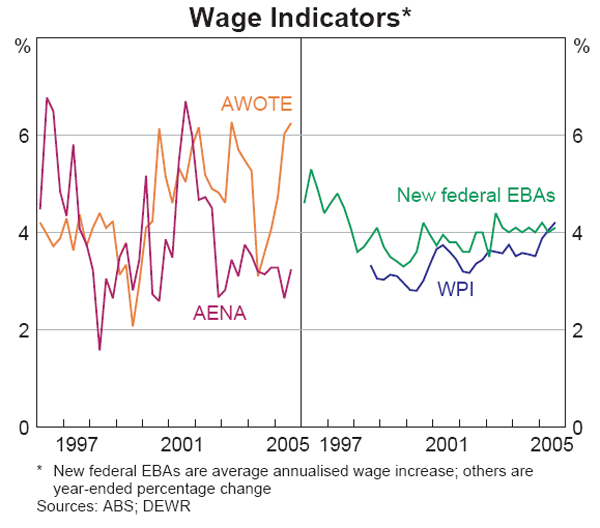Statement on Monetary Policy – February 2006 Box D: Measures of Labour Costs
Information about labour costs is important for assessing inflation trends and prospects. In Australia, there are a number of alternative measures that help to summarise economy-wide developments in labour costs. Four that are commonly cited are average weekly ordinary-time earnings (AWOTE), average earnings from the national accounts (AENA), the wage price index (WPI), and wage increases in enterprise bargaining agreements (EBAs). Each measure captures a slightly different aspect of labour costs and so can give a different signal about wage growth at any given time (Graph D1). This box discusses these measures of labour costs and the indications they are currently giving about inflationary pressures.

Both AWOTE and AENA are measures of the average wage bill. That is, they are designed to measure the average level of labour costs per employee. AWOTE measures the ordinary-time average weekly earnings of non-farm wage and salary earners who work full time. AENA, which is based on a different survey, also includes part-time workers, along with non-wage costs (such as bonuses, superannuation, workers' compensation and redundancy payments) and irregular wage payments. However, both of these measures can be affected by changes in the composition of labour that firms use. Importantly, these measures are also sensitive to changes in the sample of respondent firms and sometimes give volatile and divergent pictures of growth in labour costs.
In contrast, the WPI and EBAs provide measures of changes in wage rates. The WPI is designed to measure changes in the cost of employing a constant quantity and quality of labour. The hourly wage rate for a given job is compared with the wage rate for that same job in the previous quarter, with an attempt made to exclude wage changes resulting from changes in the nature of work performed, hours worked and the characteristics of the job occupant (such as age or experience). The WPI is then constructed as the average change in the adjusted wage rates for a fixed basket of jobs. By design, it is not affected by compositional change and so is unaffected by many of the sampling issues that cloud interpretation of growth in other measures. But being narrower in scope, the WPI may exclude wage movements stemming from a range of cyclical influences, such as increased rates of promotion in a tight labour market. Furthermore, on average, it would be expected to grow more slowly than a wage bill measure, given that there is a longer-term increase in the share of higher-skilled occupations.
Changes in wage rates can also be identified for that group of employees whose wages are governed by EBAs. Most often cited is the average annualised wage increase in all new certified federal agreements. It is calculated over the life of an agreement, and excludes bonuses and most non-wage payments. Although the population of new agreements is entirely different each quarter, the limited variation in outcomes of enterprise agreements within industries reduces the effects of compositional change. Consequently, the EBA series is less volatile than wage bill measures.
The various measures of labour costs each serve different purposes. When assessing inflationary pressures from labour costs, the most relevant concept is unit labour costs (ULCs) – that is, total labour costs (or the wage bill) per unit of output produced.[1] In principle, the wage bill component of ULCs is most fully captured by AENA because it has the broadest coverage of labour costs and its construction is consistent with the output measure used. However, in practice, the volatility of AENA, together with volatility in data for productivity, results in fairly noisy estimates of changes in ULCs. Accordingly, an assessment of inflationary pressures still requires consideration of the full range of wage measures, paying attention to their conceptual differences. On one hand, the WPI and EBAs are subject to less volatility than measures of the wage bill, and are likely to be more helpful in gauging short-term wage movements. On the other hand, the wage bill measures include elements of labour costs that are important for gauging inflationary pressures over longer horizons.
The short-term volatility in the wage bill measures is particularly evident in the data for the year to the September quarter. One simple way of reducing this volatility is to look at the average of growth in the two wage bill measures. Table D1 summarises the range of wage indicators over the year and compares them with their trend growth rates since the September quarter 1997 (the period for which the WPI is available). The composite wage bill measure would suggest that wage inflation was running above its longer-term trend rate (4.8 per cent versus 4.2 per cent). Growth in the WPI was also running above its longer-term trend rate by a broadly similar margin, while growth in EBAs was only slightly above its average. On balance, therefore, the various wage measures are running somewhat above their average rates for the past eight years, which would suggest that labour cost pressures may be adding to inflation.
| Average annualised September qtrs 1997–2005 |
Year to September qtr 2005 |
|
|---|---|---|
| WPI | 3.5 | 4.2 |
| EBAs | 3.9 | 4.1 |
| AWOTE | 4.7 | 6.3 |
| AENA(a) | 3.6 | 3.2 |
| Average of wage bill measures | 4.2 | 4.8 |
|
(a) Measured in per hour terms Sources: ABS; RBA |
||
Or, equivalently, growth in the average wage bill minus growth in labour productivity. [1]